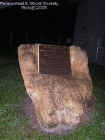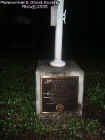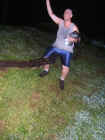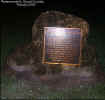| |
The Debary Veteran's Memorial Park was developed
in 1999 Memorial Day to the local veterans and war heroes. The 2.5 acres
of land was donated by the Gray family to the city of Debary as a place to
recognize individuals and groups. The Gray family was quite prominent to
the area such as the were the previous owners of Gemini Springs.
On the parks property is an F-15 Eagle Air
Craft and the USS Langley's anchor which are displayed within the park.
The air craft is displayed over looking the garden which is illuminated in
the evenings so passing drivers can enjoy the view.
The grounds have picnic shelters, benches, and
plaques. I really enjoyed visiting here although at night has a real eerie
sense. Nearby are these giant electrical towers perhaps that is why their
is such a high energetic feeling here. But what is more impressive is
seeing the giant anchor from USS Langley which was this countries first
aircraft carrier so lots of history.
Keep in mind some of these men died in pearl
harbor like when the USS Langley sunk so its quite possible their are some
veteran ghost that lurk within the memorial park. Other then that their is
not much other history to it since the park is fairly new. The plane is
very amazing considering its size and is dedicated to a veteran who once
flew in it just as another memorial talks about how the remains of one
soldier are buried fairly close in one of the local cemeteries.
© By
Rick-AngelOfThyNight











History Of The USS Langley
Jupiter
(AC-3) was laid down 18 October 1911 by Mare Island Navy Yard, Vallejo,
Calif.; launched 14 August 1912; sponsored by Mrs. Thomas F. Ruhm; and
commissioned 7 April 1913, Comdr. Joseph M. Reeves in command.
After successfully passing her trials, Jupiter, the first
electrically-propelled ship of the U.S. Navy, embarked a Marine detachment
at San Francisco and reported to the Pacific Fleet at Mazatlan, Mexico, 27
April 1914, bolstering U.S. naval strength on the Mexican Pacific coast
during the tense days of the Vera Cruz crisis. She remained on the Pacific
coast until she departed for Philadelphia, 10 October. En route, the
collier steamed through the Panama canal on Columbus Day — the first
vessel to transit it from west to east.
Prior to America's entry into World War I, she cruised the Atlantic and
Gulf of Mexico attached to the Atlantic Fleet Auxiliary Division. The ship
arrived Norfolk 6 April 1917, and, assigned to Naval Overseas
Transportation Service (NOTS), interrupted her coaling operations by two
cargo voyages to France in June 1917 and November 1918. She was back in
Norfolk 23 January 1919 whence she sailed for Brest, France, 8 March for
coaling duty in European waters to expedite the return of victorious
veterans to the United States. Upon reaching Norfolk 17 August 1919, the
ship was transferred to the west coast. Her conversion to an aircraft
carrier was authorized 11 July 1919, and she sailed to Hampton Roads, Va.,
12 December where she decommissioned 24 March 1910.
Jupiter was converted into the first U.S. aircraft carrier at the Navy
Yard, Norfolk, Va., for the purpose of conducting experiments in the new
idea of seaborne aviation, a field of unlimited possibilities. Her name
was changed to Langley 11 April 1920; she was reclassified CV-1 and
recommissloned 20 March 1922, Comdr. Kenneth Whiting in command.
As the first Navy carrier, Langley was the scene of numerous
momentous events. On 17 October 1922 Lt. Virgil C. Griffin piloted the
first plane, a VE7-SF, launched from her decks. Though this was not the
first time an airplane had taken off from a ship, and though Langley
was not the first ship with an installed flight-deck, this one launching
was of monumental importance to the modern U.S. Navy. The era of the
aircraft carrier was born introducing into the Navy what was to become the
vanguard of its forces in the future. With Langley underway 9 days
later, Lt. Comdr. G. DeC. Chevalier made the first landing in an Aeromarine.
On 18 November Commander Whiting, at the controls of a PT, was the first
aviator to be catapulted from a carrier's deck.
By 15 January 1923 Langley had begun flight operations and tests in
the Caribbean for carrier landings. In June she steamed to Washington,
D.C., to give a demonstration at a flying exhibition before civil and
military dignitaries. She arrived Norfolk 13 June and commenced training
along the Atlantic coast and Caribbean which carried her through the end
of the gear. In 1924 Langley participated in more maneuvers and
exhibitions, and spent the summer at Norfolk for repairs and alterations,
she departed for the west coast late in the year and arrived San Diego 29
November to join the Pacific Battle Fleet. For the next 12 years she
operated off the California coast and Hawaii engaged in training fleet
units, experimentation, pilot training, and tactical-fleet problems. On 25
October 1936 she put into Mare Island Navy Yard, Calif., for overhaul and
conversion to a seaplane tender. Though her career as a carrier had ended,
her well-trained pilots proved invaluable to the next two carriers, USS
Lexington
(CV-2) and USS
Saratoga
(CV-3).
Langley completed conversion 26 February 1937 and was reclassified
AV-3 on 11 April she was assigned to Aircraft Scouting Force and commenced
her tending operations out of Seattle, Sitka, Pearl Harbor, and San Diego.
She departed for a brief deployment with the Atlantic Fleet from 1
February to 10 July 1939, and then steamed to assume her duties with the
Pacific fleet at Manila arriving 24 September.
At the outbreak of World War II, Langley was anchored off Cavite,
Philippine Islands. She departed 8 December and proceeded to Balikpapan,
Borneo, and Darwin, Australia, where she arrived 1 January 1942. Until 11
January Langley assisted the Royal Australian Air Force (RAAF) in
running antisubmarine patrols out of Darwin. She was then assigned to
American-British-Dutch-Australian forces assembling in Indonesia to
challenge the Japanese thrust in that direction. She departed Fremantle,
Australia, 22 February in convoy, and left the convoy 5 days later to
deliver 32 P-40s to Tjilatjap, Java.
Early in the morning 27 February 1942, Langley rendezvoused with
her antisubmarine screen, destroyers USS Whipple (DD-217) and USS
Edsall (DD-219). At 1140 nine twin-engine enemy bombers attacked her.
The first and second Japanese strikes were unsuccessful; but during the
third Langley took five hits. Aircraft topside burst into flames,
steering was impaired, and the ship took a 10 degree list to port. Unable
to negotiate the narrow mouth of Tjilatjap Harbor, Langley went
dead in the water as in-rushing water flooded her main motors. At 1332 the
order to abandon ship was passed. The escorting destroyers fired nine
4-inch shells and two torpedoes into the old tender to insure her sinking.
She went down about 75 miles south of Tjilatjap with a loss of 16.
|
|














